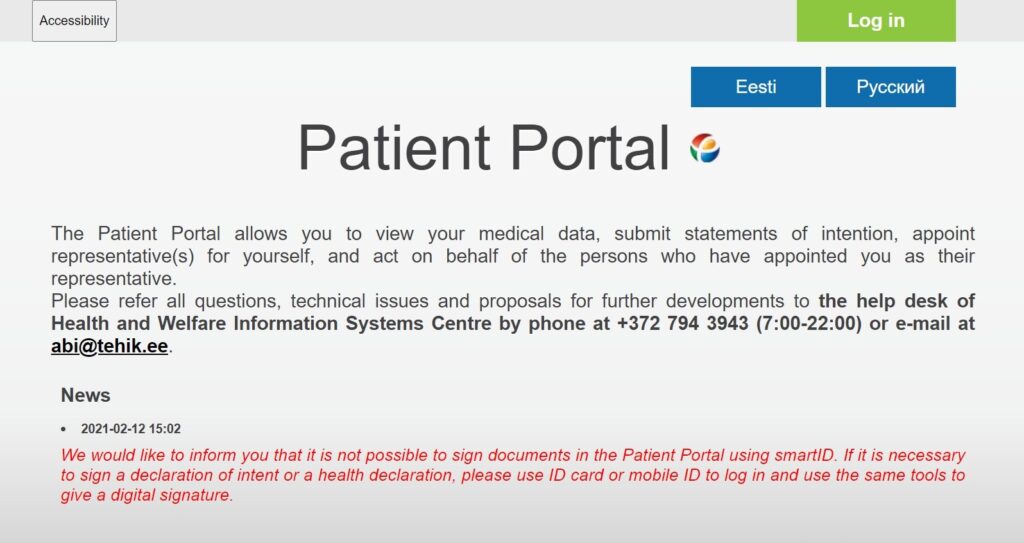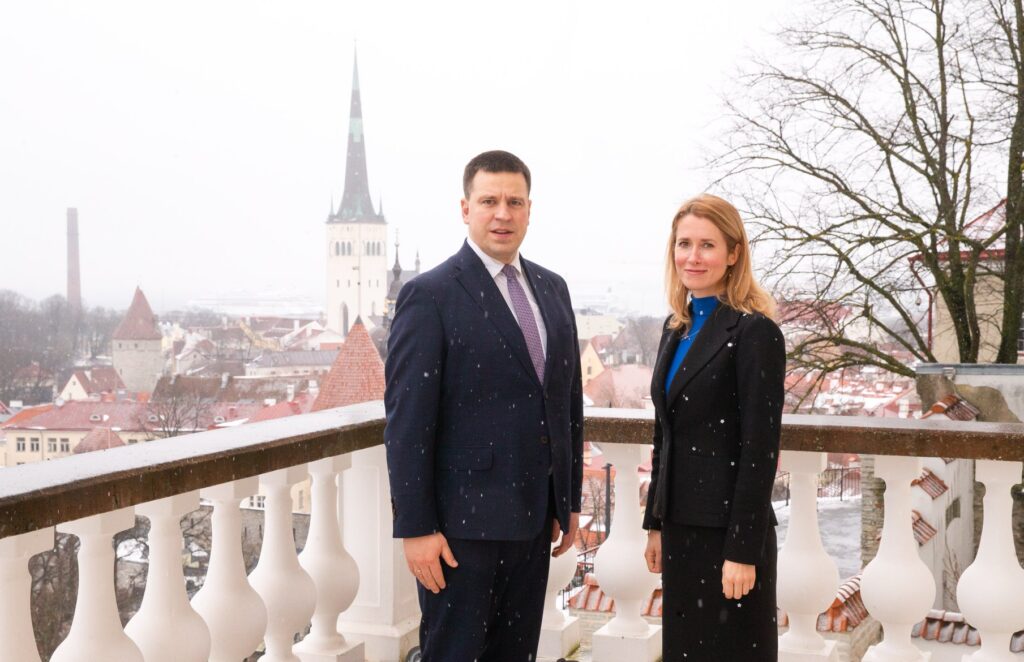Keegan McBride, who has played an active role in sharing information about the novel coronavirus pandemic in Estonia, says in an interview with Estonian World that the country’s current government, headed by Kaja Kallas and her Reform Party, is hypocritical, making the same mistakes they criticised the previous government for; according to McBride, the government needs to listen to its scientists and prioritise the health and wellbeing of its citizens over politics.
Keegan McBride first came to Estonia in 2013 to study at the University of Tartu and in 2015, moved back permanently to Estonia where he completed his doctoral studies at Tallinn University of Technology’s Public Administration programme in 2020. Keegan has played an active role in disseminating information about the COVID-19 pandemic in Estonia since the beginning, due to his work with the Estonian open data portal, his management of koroonakaart.ee (an information portal that provided multilingual real-time data on the coronavirus in Estonia), and more recently piirangud.ee (a site that maintains up-to-date information on the current restrictions in Estonia).
As an international expert on bureaucracy and public administration, McBride offers a sharp and neutral assessment on the Estonian government’s handling of the COVID-19 pandemic in a country where the situation is now getting worse day-by-day.

According to the Estonian Health Board statistics on 7 March, in the previous 24 hours, the country added 1,321 new coronavirus cases. The infection rate in the preceding 14 days per 100,000 inhabitants was 1,309.05. The Reuters coronavirus tracker says new infections in Estonia are at their peak and that there have been 75,003 infections and 653 coronavirus-related deaths reported in the country since the pandemic began.
At the same time, the country is dragging its feet with the vaccination against the virus. So far, only 43,942 people in Estonia have received both doses of the vaccine – that is 3.3% of the population. A little over 100,000 people have received at least one dose – and even that is just 7.633% of the Estonian population.
In an interview with Estonian World, McBride says the vaccines and the pandemic have become a political game, used to attack and score political points. McBride highlights serious managerial and organisational issues at the Estonian social affairs’ ministry. Because of the public sector cuts, Estonia’s usually much praised digital state has underdelivered too. He says also the current government, headed by Kaja Kallas and her Reform Party, is hypocritical, making the same mistakes they criticised the previous government for. McBride indicates that if the government doesn’t do more now to solve the crisis, the situation in Estonia will get a whole lot worse.
Keegan McBride, the Estonian government has said on multiple occasions that nobody could have seen this coming, and that the restrictions currently in force are as strict as they were last year. Is this true?
Is this true, certainly not. Either the government actually believes this to be true, in which case they would be incompetent – or they know this is not true, and they are saying it anyway, which is disturbing.
The fact is that in the end of 2020, it was abundantly clear that the pandemic was getting worse, and that it had the possibility to spiral out of control quickly. To be clear, the blame for this cannot be placed completely on the head of the new government (Kaja Kallas – editor), but the blame must be shared – and a larger part of it likely lies with the previous government.
Let’s look at what we do know. On 8 December, Krista Fischer (Estonian mathematician and a member of the science council advising the government on the crisis), said on her Facebook page that the government’s restrictions did not go far enough. Instead of listening, the then-prime minister, Jüri Ratas, scolded the scientist.
On 23 December, Fischer once again warned that if restrictions were not tightened, February would be critical for the Estonian health-care system.
Tanel Tenson, the scientist running the COVID-19 sewage water surveys, highlighted in December that the virus had made its way across Estonia, and in January, the levels would be increasing rapidly. He too sounded a warning that things were going to get worse.
The message from scientists across the board was clear – if more restrictions were not put in place, a disaster was coming to Estonia.

At the same time, as the situation was deteriorating in Estonia, its southern neighbours Latvia and Lithuania were in a health-care system crisis, their hospitals were overburdened. The future for Estonia was clear to anyone who looked next door. While all of this was happening, news came from the UK that a new variant of the virus was spreading that was more contagious – the WHO and the European Centre for Disease Prevention and Control warned governments to be prepared for it.
Indeed, all throughout January scientists directly involved in the study of COVID-19, as well as those who followed the statistics for their own interest, saw what was coming. So, to say that no one saw this coming is simply irresponsible and not in line with reality.
This takes us to the second part of the question, are the restrictions in place now the same as they were in the first emergency situation, in spring 2020? Here, too, the facts are not in agreement with the government’s argument.
To see this clearly, we can turn to Oxford’s stringency index, which measures government policy responses to COVID-19. As can be seen from the index, in the early stages of the crisis, Estonia had a high policy response, above both Latvia and Lithuania. But during the second wave of the crisis, we have the lowest response of the four countries, with decreases in restrictions preceding the rapid growth of COVID-19 in Estonia in early February. So, once again, to argue that things are as strict as they were before is disturbing.

The science council is calling for tightening of restrictions – and yet the restrictions do not follow.
Does the government have a handle on the current COVID-19 situation?
What we know is that there is a lag effect with COVID-19. It is only later that hospitalisations and deaths start to rise. Changes and restrictions that come into effect, won’t make their impact known for weeks into the future.
The fact is that today – and this has been said publicly by the director of the Estonian Health Board, Üllar Lanno, as well – the health board has lost control. In some areas we are not able to contact trace.
While the WHO recommends the percentage of positive tests remains below 10%, Estonia’s average over the past two weeks has been around 16%, with many days having 20% of tests returning positive. In practice, this means that the true percentage of positive cases inside Estonia is a large degree higher than the 1,500 positive cases per day we are seeing now.
The solution would be to test more, but we cannot – Estonia appears to be have reached or at least neared the top of its testing capacity. Our hospitals are overrun, and in Tallinn, ambulances are running every 20 minutes with a COVID-19 patient (Tallinn’s ambulance service’s chief doctor, Raul Adlas, said on 6 March that the service had been working at full capacity for the past couple of weeks and around half of calls lead to a patient having to be hospitalised immediately – editor). This is the situation the public sees – and it is frightening.

One thing is clear, there are serious managerial and organisational issues at the ministry of social affairs. These issues are not of the type that would appear within a matter of days, weeks or months – and responsibility for them cannot be fully placed on the minister (the minister of health and labour, Tanel Kiik, Centre Party – editor) – but rather lies at the counsellor level and is managerial in nature. Some names that are often being voiced as playing a role in the serious mishandling of this crisis are Üllar Lanno, Maris Jesse (the deputy secretary general on health at the ministry) and Marika Priske (the secretary general at the ministry ).
These weaknesses and lack of preparedness are not new. For years, the National Audit Office of Estonia has been highlighting the lack of preparedness by the ministry and its agencies for a crisis. Academic theses have been written about this. The Estonian Health Board has failed numerous emergency and crisis simulations. The fact that these organisations have faltered is not surprising.
However, I would like to point out that the blame for this cannot and must not be directed at the employees of the ministry. Devoted civil servants have worked – and continue to work – tirelessly at fighting this pandemic to the best of their ability with the tools they have. The fact they have been constrained by poor managerial practices is unsettling.
How does this influence Estonia’s lacklustre performance with vaccines to date?
When it comes to vaccination in Estonia, there are two issues at play. One is that you need to have vaccines available, and this has so far been dictated by the terms of the European Union’s joint procurement. The second is the logistics and roll out of vaccinations.
When it comes to obtaining vaccinations, the government has shown itself to be hesitant to express any form of innovation or proactivity. It is easier for the government to not act proactively – trying to obtain vaccines by other means – as any attempts that fail could carry political risks. If they continue down the current path, it is always possible to blame the EU for the lack of vaccines being available.
While Kaja Kallas was in the opposition, she repeatedly highlighted the need for innovation and called for every attempt to be exhausted to obtain vaccines – yet, now as PM, one can certainly not say this has been done. Vaccination in Estonia has become part of the political mathematics, and Estonian lives are the cost; this is unacceptable.

Regarding the logistics, there has been a number of issues at play. First, regulation and data protection have put a serious damper on the compilation of risk group lists and vaccination schedules. A large amount of regulation and legislation has slowed down the process. These issues had remained hidden from the public eye, but have recently begun to be reported in the press.
Another issue is related to communication. Recent surveys have shown that the number one reason Estonians are hesitant or refusing to get vaccinated is due to a lack of information. In fact, this is a fair criticism of the government’s COVID-19 response across the board – communication has been, and continues to be, poorly conducted. From lack of awareness about vaccines, to poor communication of the current restrictions in place, to providing information to all residents and citizens of Estonia – almost no communication plan has gone well, or even existed.
There are other issues related to the roll out of the vaccine such as requiring nurses to act as sales agents; calling individuals and asking them to come for a vaccination, instead of allowing them to pre-register. Some family doctors’ offices have received many vaccines, while some have requested none.
When doses are going to go to waste because people do not show up, there is no official waiting list for those who wish to get vaccinated to receive such doses instead. If a large number of vaccines did become available, it is not yet clear how Estonia would engage in any sort of mass vaccination programme. I hope such a plan does exist, but the government has not communicated this yet.
Last year, when the COVID-19 pandemic first hit, we were seeing stories in global outlets, created by journalists in London, New York and elsewhere, as if Estonia was handling the crisis better than other countries, thanks to its digital state. Was it actually so?
I have written extensively about this, and it has caused many friends and colleagues to scorn me, but the fact is the digital state has not performed as well as one would have hoped during this time of crisis.
Yes, some parts of the e-state (a digital state, or in Estonia, also dubbed e-Estonia – editor) worked phenomenally. A clear example of this is the amazing work that TEHIK (the Estonian Health and Welfare Information Systems Centre) has done to make data available in an open format – Estonia is probably a leader when it comes to making COVID-19 data available. But, in many other regards, the e-state did not help.

The primary reason for this is that digital tools cannot be a replacement for experience, capacity, and capability. The public sector in Estonia has suffered for a year from underfunding and job cuts that have severely limited its ability to perform as it needs to – but the idea of expanding the state is not popular here, so the trend continues.
The lack of funding for digital government has been clear for years and its effects are noticeable during this pandemic. Small and devoted teams of public servants in ministerial IT offices must simultaneously maintain legacy infrastructure, procure new services and develop innovation with less people and less money than before. This obviously translates to a decrease in performance.
In the summer of 2020, the ministry of social affairs launched a coronavirus close contact notification app called “HOIA”. Estonian newspaper Postimees recently reported that the app had not managed to reach its potential in terms of helping contain the virus. What could have gone possibly wrong?
The HOIA application started off as a good idea, but quickly faltered. This application was built as a pro bono cooperation between a number of Estonian IT companies. The project manager was based at TEHIK, but once the project was completed, the employee left to a new position. That left the ownership of the application in unsure hands.
Several shortcomings quickly became clear. First, from the government perspective, they could not get actionable statistics from the app (this was a design choice and made with privacy in mind). Second, there likely is not enough smart phone users in Estonia for this app to reach the penetration level needed for it to become highly useful. Third, it is not compatible with the EU’s interoperability framework for such applications.

There were a number of other issues with the app, which led to a procurement being offered for the improvement and maintenance of HOIA. The first procurement failed. A new procurement has been prepared, but progresses slowly.
All signs seem to point that this app will have had minimal impact, cost a large amount of money, and not be ready by the time the pandemic begins to lull, at which point it may not even be needed.
Estonia is currently second in Europe in terms of new coronavirus infections. What the previous and the new government could have done differently to avoid this ever-concerning situation?
The government needs to listen to its scientists and prioritise the health and wellbeing of its citizens over politics. If they do that, they will be already on the right path. Debating a balanced budget and discussing spending, while hundreds of citizens are in hospitals and tens are dying every day, is a disservice to Estonia.
Tanel Kiik, the current minister of health and labour, was also in the same position in the Ratas’ government – he is at least partly responsible for the decisions made in the ministry of social affairs since the pandemic started in early 2020. Should he take the responsibility for the blunders?
As I said previously, there are serious managerial and organisational issues at the ministry of social affairs, but these predate Tanel Kiik. So, while he certainly needs to shoulder some of the blame, it must not fall on him alone.
However, he should make a clear and public effort to outline what these shortcomings have been so far and offer concrete solutions and paths forward in overcoming them.

Should the government offer more financial support to businesses that suffer economically due to the crisis?
Now is not the time to debate budgets, the government must ensure it takes care of its businesses and citizens, the cost of doing otherwise is too great.
What do you think should be the government’s action plan now, considering the critical COVID-19 situation in Estonia?
The government struggles with communication and this leaves the population in a state of confusion. Without clear communication, it is hard to understand what the government is doing. This must be improved, moving forward.
Second, the government needs to acknowledge the reality of the situation we are in. It is already bad. They have not added many new restrictions that are likely to be effective. This means that in the next month and forward, it is going to get worse.
Now is not the time for politics and indecisiveness. Hard decisions need to be made and they need to be made now – every day we wait makes the future recovery harder. Üllar Lanno has said that if we constantly have 1,500 to 1,600 positive cases each day, then we must lock down the country – we are already there and past it.
The government knows what needs to be done; the question is whether they have the will to put country over politics. I hope they do.
Please note that the Estonian government imposed new restrictions on the evening of 8 March.
Cover: Kaja Kallas (right), the current prime minister of Estonia, and her predecessor, Jüri Ratas (left), on the balcony of the Stenbock House, the seat of the Estonian government, on 26 January 2021. Photo by Stenbock House.

